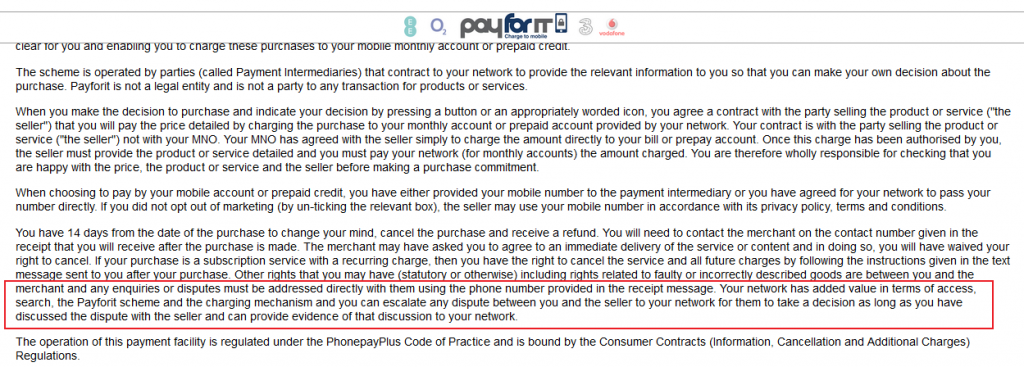If you have discussed your case with the “service” that took your money, then under the Payforit rules you are entitled to escalate your dispute to your mobile network. Getting networks to take this responsibility can be an uphill struggle.

In pursuing your case, use the following points
- Provide details of your dispute with the service provider and evidence that you have discussed the matter with them
- State the terms of any offer made by the “service provider” and detail any evidence they provided of your “consent” to the charges
- State that under the Payforit rules you are now entitled to escalate the dispute to your network
- Make it clear that you did not consent to the charges and that any supposed consent must have been the result of malicious code on a webpage or in an App. Remind them that the regulator has found such exploits to be commonplace and that fines have been issued to companies found to be using them.
- As a first step, you should use the normal process of discussing your case with a Customer Services representative. Make it clear that you are aware of your right, under the Payforit rules, to escalate your dispute to them. Be insistent! When they refuse to help, try asking to speak to a manager. Try to escalate your complaint as far as you can, and if ultimately refused, ask for an email to confirm the refusal.
You need to be clear about what you want as a resolution of your dispute. Ask for any of the items below that have not already been provided. In reality though, all you are likely to get is the refund. However, if a refund has been refused, you are entitled to see the other items that form proof of your consent.
- A full refund of all the charges taken together with any costs incurred in pursuing your case.
- Screenshots of the subscription workflow where you were alleged to have signed up for this service.
- A description of what the service you are supposed to have subscribed to provides? Is this a newsletter, access to a web portal?
- Any evidence that after supposedly signing up for the service, you actually used it
- The complete web server log of the subscription, including the User Agent strings containing all device details (browser, device type, device IP address) together with dates and times.
- Full company details of the company operating the service, country of registration, full name of company, company number and registered company address.
If you have reached the end of the line with Customer Services, you will need to raise a formal complaint. Each network has it’s own rules and procedures for this. It’s worth using the online dispute resolution service, Resolver (https://www.resolver.co.uk/ ) if you can. You can do this for most of the major networks. You need to be really clear that you are not complaining about Payforit directly, but about your network’s failure to accept escalation as provided for under the Payforit rules.
It might also be worth acquainting yourself with your network’s rules and procedures for dealing with Payforit. These require your network to investigate complaints when customers are unhappy with a response from a service provider.
If no specific procedures have been published for your network, the network should be following the Payforit Code of Practice.

